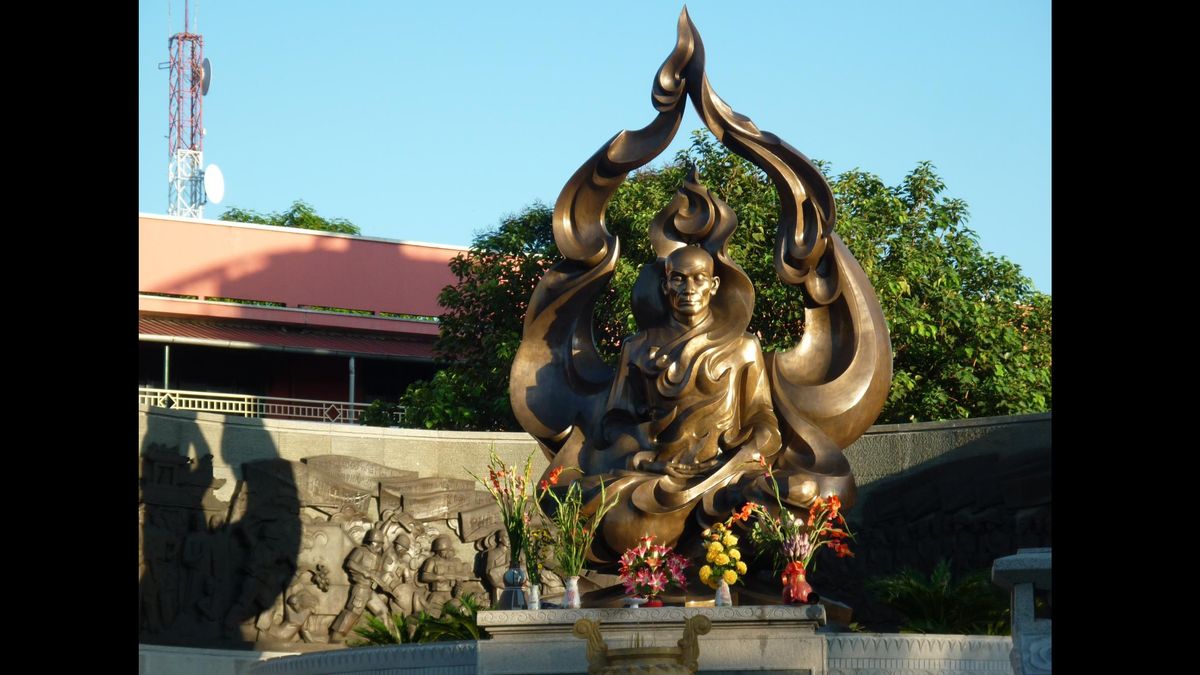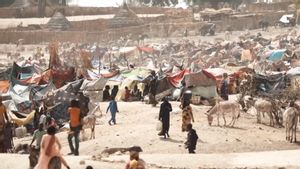JAKARTA - On June 11, 1963, the monk Thich Quang Duc set himself on fire. A historic event in Vietnam that changed many things. Not only in that country but also in the world.
The self-immolation of the monk Thic Quang Duc was carried out as a form of protest against the South Vietnamese government which did not provide freedom of religion. The government also implies laws that are very demanding and unfair to Buddhists.
The monk set himself on fire to death on the spot. Prior to this incident, on May 8, 1963, Buddhists in Vietnam celebrated a special day in Hue City.
This special day is called Phat Dan or Buddha's birthday. The streets are packed with people from all over Vietnam who come to celebrate this special day.
Most people waved the Buddhist flag at that time. What should be noted is that at that time the flying of flags with religious elements was prohibited in Vietnam. This law was implemented by President Ngo Dinh Diem who is a Catholic.
The law was implemented because he wanted to make Vietnam more prosperous and sought to "Catholicize" Vietnam, which is predominantly Buddhist. Religion is a big part of Vietnamese culture and trying to change the culture of a nation will not make anyone happy.
Citing History of Yesterday, on the day of the celebration, President Diem sent armed police reinforced by the Vietnamese army. The celebrations turned into massive protests and things spiraled out of control.
As soon as the Army lost its temper, they opened fire into the crowd. By the end of the day, more than a hundred people were injured and 9 people died.
Of the nine people, two of them were children who were run over by police cars and army trucks. Since the massacre, the situation in Vietnam has escalated and protests have taken place across the country.
The news that set Duc on fire
Finally, two months after the massacre, the news reached Thich Quang Duc's ears. Duc learned the news late because he lived in a completely isolated temple in the mountains of Vietnam.
He also spent the last three years of his life in this temple. As soon as he got news of the massacre, he knew that something had to be done to keep Buddhists safe.
On a street outside the Cambodian Embassy in Saigon, about 350 monks and nuns lined up. The motorcade was led by a Westminster sedan carrying banners printed in English and Vietnamese.
They criticized President Diem's government and its policies towards Buddhists, and demanded fulfillment of the promise of religious equality. The car stopped.
Duc burn himselfDuc was seen getting out of the car with two monks. One of the monks placed the mat in the middle of the road and the other monk took out a jerry can of gasoline.
People then formed a circle, surrounding Duc who was sitting in the lotus position on a sitting mat. A student pours gasoline on Duc's body.
Duc then twisted a prayer necklace made of wood and recited Nian Fo's chant. Then the fire was lit.
The flames immediately devoured Duc's body and black smoke billowed from his burning body. For ten minutes he sat in a meditative position until he finally fell.
Most of the people present watched Duc die. "I don't know exactly when he (Duc) died because you don't know from his body or his voice or whatever," said a photographer who helped capture the moment, Malcolm Browne.
"She didn't scream in pain. Her face was so calm that it was so blackened by the fire that you couldn't get out anymore. Eventually the nuns decided she was dead and they brought a coffin, a wooden coffin," Browne added.
The role of the photographer Malcom BrowneThe day before Thich Quang Duc's self-immolation, the Saigon Bureau Chief for the Associated Press named Malcolm Browne was informed by anonymity. The news said something important would happen outside the Cambodian Embassy.
Due to the high tension surrounding Vietnam, Browne trusted this information. The next day, Malcolm Browne arrived at the Cambodian Embassy.
At that time he saw Thich Quang Duc with 350 monks and nuns who took part in the protest. At this point, Browne was still unaware of what was about to happen.
Browne witnessed it all, as Thich Quang Duc sat on a pillow with his legs crossed and was doused with gasoline. Browne set up his camera to ensure that he would capture every moment of it and everyone around the world would hear about this act.

Browne had no idea that what happened next would be more stressful and career-changing. As soon as Duc finished praying, fire was ignited in Duc's body and all the people watching panicked.
"Everyone who witnessed this was horrified. Each time it looked worse than I expected," Browne said in an interview with TIME.
In the interview Browne recounted what it was like to witness someone who set himself on fire for the sake of sacrifice. The action gave off a very strong smell, which was too horrible to even describe.
Especially with the fact that the monks present mourned Duc and saw his near death. "The main voice is the lament and misery of the monks, who had known this man (Duc) for many years before."
"Then there was screaming over the loudspeaker between the firefighters, trying to figure out a way to put it out, put out the fire so it wouldn't kill him or something. It was all mixed confusion."
Duc's fire ignites the world's reactionAfter the fire was extinguished, the monks took Duc's body to the pagoda to be cremated. Just minutes after the cremation, the pagoda was stormed by police who ensured that news of this incident did not spread.
But too late. Browne has sent photos of the incident to the United States (US). The photo was sent along with a letter explaining the action.
In the days that followed, pictures of the burning Thich Quang Duc appeared on the front covers of newspapers around the world. Thich Quang Duc's sacrifice and Browne's responsiveness to producing these photos led other countries to pressure the Vietnamese government to change the law to suit the Buddhist community.
This type of ultimate protest has proven that the world cannot be changed without terrible sacrifices. Browne's pictures do provide information for many people around the world.
But the experience Browne faced firsthand was incomparable. Browne was awarded the Pulitzer Awards for International Reporting as well as the World Press Photo of the Year in 1963. Browne died August 27, 2012 at the age of 81.
*Read other information about WORLD HISTORY or read other interesting articles from Putri Ainur Islam.
TODAY'S HISTORY MoreThe English, Chinese, Japanese, Arabic, and French versions are automatically generated by the AI. So there may still be inaccuracies in translating, please always see Indonesian as our main language. (system supported by DigitalSiber.id)












